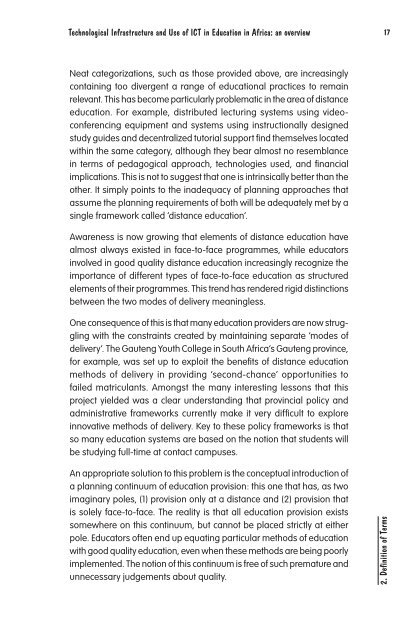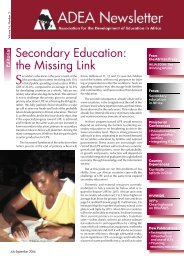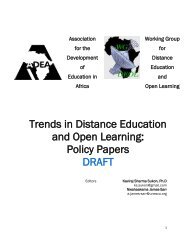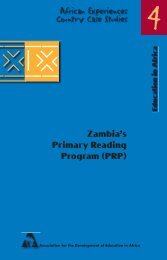Technological Infrastructure and Use of ICT in Education in ... - ADEA
Technological Infrastructure and Use of ICT in Education in ... - ADEA
Technological Infrastructure and Use of ICT in Education in ... - ADEA
Create successful ePaper yourself
Turn your PDF publications into a flip-book with our unique Google optimized e-Paper software.
<strong>Technological</strong> <strong>Infrastructure</strong> <strong>and</strong> <strong>Use</strong> <strong>of</strong> <strong>ICT</strong> <strong>in</strong> <strong>Education</strong> <strong>in</strong> Africa: an overview<br />
17<br />
Neat categorizations, such as those provided above, are <strong>in</strong>creas<strong>in</strong>gly<br />
conta<strong>in</strong><strong>in</strong>g too divergent a range <strong>of</strong> educational practices to rema<strong>in</strong><br />
relevant. This has become particularly problematic <strong>in</strong> the area <strong>of</strong> distance<br />
education. For example, distributed lectur<strong>in</strong>g systems us<strong>in</strong>g videoconferenc<strong>in</strong>g<br />
equipment <strong>and</strong> systems us<strong>in</strong>g <strong>in</strong>structionally designed<br />
study guides <strong>and</strong> decentralized tutorial support f<strong>in</strong>d themselves located<br />
with<strong>in</strong> the same category, although they bear almost no resemblance<br />
<strong>in</strong> terms <strong>of</strong> pedagogical approach, technologies used, <strong>and</strong> f<strong>in</strong>ancial<br />
implications. This is not to suggest that one is <strong>in</strong>tr<strong>in</strong>sically better than the<br />
other. It simply po<strong>in</strong>ts to the <strong>in</strong>adequacy <strong>of</strong> plann<strong>in</strong>g approaches that<br />
assume the plann<strong>in</strong>g requirements <strong>of</strong> both will be adequately met by a<br />
s<strong>in</strong>gle framework called ‘distance education’.<br />
Awareness is now grow<strong>in</strong>g that elements <strong>of</strong> distance education have<br />
almost always existed <strong>in</strong> face-to-face programmes, while educators<br />
<strong>in</strong>volved <strong>in</strong> good quality distance education <strong>in</strong>creas<strong>in</strong>gly recognize the<br />
importance <strong>of</strong> different types <strong>of</strong> face-to-face education as structured<br />
elements <strong>of</strong> their programmes. This trend has rendered rigid dist<strong>in</strong>ctions<br />
between the two modes <strong>of</strong> delivery mean<strong>in</strong>gless.<br />
One consequence <strong>of</strong> this is that many education providers are now struggl<strong>in</strong>g<br />
with the constra<strong>in</strong>ts created by ma<strong>in</strong>ta<strong>in</strong><strong>in</strong>g separate ‘modes <strong>of</strong><br />
delivery’. The Gauteng Youth College <strong>in</strong> South Africa’s Gauteng prov<strong>in</strong>ce,<br />
for example, was set up to exploit the benefits <strong>of</strong> distance education<br />
methods <strong>of</strong> delivery <strong>in</strong> provid<strong>in</strong>g ‘second-chance’ opportunities to<br />
failed matriculants. Amongst the many <strong>in</strong>terest<strong>in</strong>g lessons that this<br />
project yielded was a clear underst<strong>and</strong><strong>in</strong>g that prov<strong>in</strong>cial policy <strong>and</strong><br />
adm<strong>in</strong>istrative frameworks currently make it very difficult to explore<br />
<strong>in</strong>novative methods <strong>of</strong> delivery. Key to these policy frameworks is that<br />
so many education systems are based on the notion that students will<br />
be study<strong>in</strong>g full-time at contact campuses.<br />
An appropriate solution to this problem is the conceptual <strong>in</strong>troduction <strong>of</strong><br />
a plann<strong>in</strong>g cont<strong>in</strong>uum <strong>of</strong> education provision: this one that has, as two<br />
imag<strong>in</strong>ary poles, (1) provision only at a distance <strong>and</strong> (2) provision that<br />
is solely face-to-face. The reality is that all education provision exists<br />
somewhere on this cont<strong>in</strong>uum, but cannot be placed strictly at either<br />
pole. Educators <strong>of</strong>ten end up equat<strong>in</strong>g particular methods <strong>of</strong> education<br />
with good quality education, even when these methods are be<strong>in</strong>g poorly<br />
implemented. The notion <strong>of</strong> this cont<strong>in</strong>uum is free <strong>of</strong> such premature <strong>and</strong><br />
unnecessary judgements about quality.<br />
2. Def<strong>in</strong>ition <strong>of</strong> Terms

















